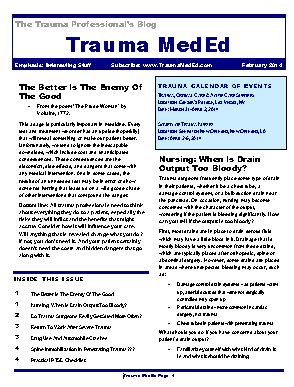Every trauma professional knows that DVT can be a real problem in their patients. Prophylaxis for and treatment of DVT is now well established for appropriate patients. However, the best laid plans can’t always be carried out. How many times have you had to delay, or even stop chemical prophylaxis because of an impending operation? And patients who need multiple operations may have multiple starts and stops.
Is this so called “prophylaxis interruptus” bad for the patient?
The trauma group at OHSU in Portland looked at this issue in a series of patients over a 4 year period. Any patient admitted to the trauma service who received at least one dose of prophylactic enoxaparin was eligible for inclusion. They enrolled 202 patients and studied them prospectively from admission, using a strict screening protocol. A total of 73 were trauma patients and 129 were general surgery patients. Any dosing regimen was allowed (bid, qd, renal adjustment).
Here are the factoids:
- The most common reason for a missed dose was an impending invasive procedure (~40%)
- BUT nearly a third had no recorded reason for the interruption!
- Overall incidence of DVT was 16% (!)
- A whopping 59% of patients missed at least one dose of enoxaparin
- Incidence of DVT in patients who never missed a dose was 5%
- Incidence of DVT in patients who missed any dose was 24% (!!)
- Age > 50 was another independent risk factor for DVT
Bottom line: Interrupting DVT prophylaxis (at least with enoxaparin) is bad! This was a small study, but the results were still dramatic. I am surprised, however, at the relatively small number of patients (50/year) from such a busy trauma program. This study confirms a small but growing number of studies that are beginning to suggest the same thing. There’s something that we don’t yet fully understand about DVT prophylaxis, and it appears that stopping it paradoxically creates a hypercoagulable state for a while.
What to do? First, pay attention! Make sure your patients don’t miss a dose if they don’t have to. Not a single one! And it looks like we’ll have to dust off some older papers (or generate some new ones) on the real vs perceived dangers of operating on patients on this drug. I have never been impressed that there is additional bleeding when performing the usual trauma surgical operations on patients who are receiving enoxaparin. But areas where even a small amount of bleeding can be dangerous (e.g. around the brain) will probably continue to cause problems.
Related posts:
Reference: Correlation of missed doses of enoxaparin with increased incidence of deep venous thrombosis in trauma and general surgery patients. JAMA Surg doi:10.1001/jamasurg.2013.3963, online first Feb 26, 2014.


